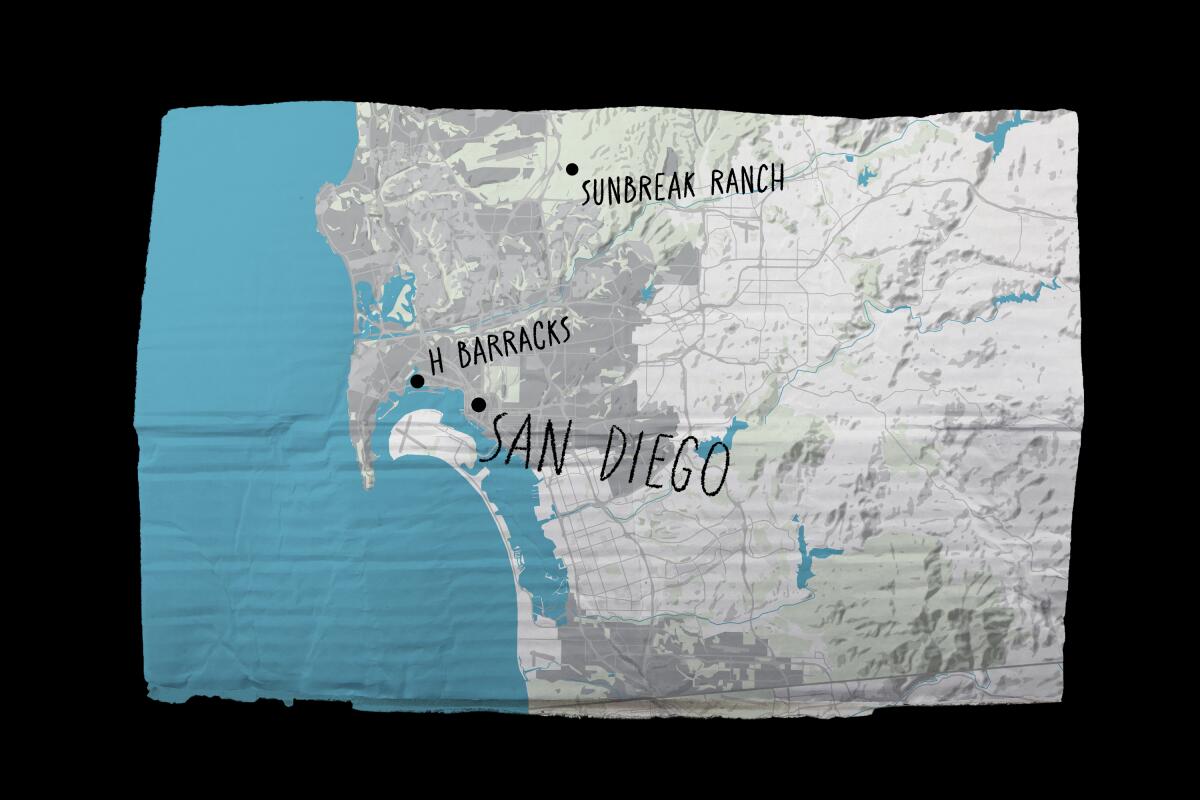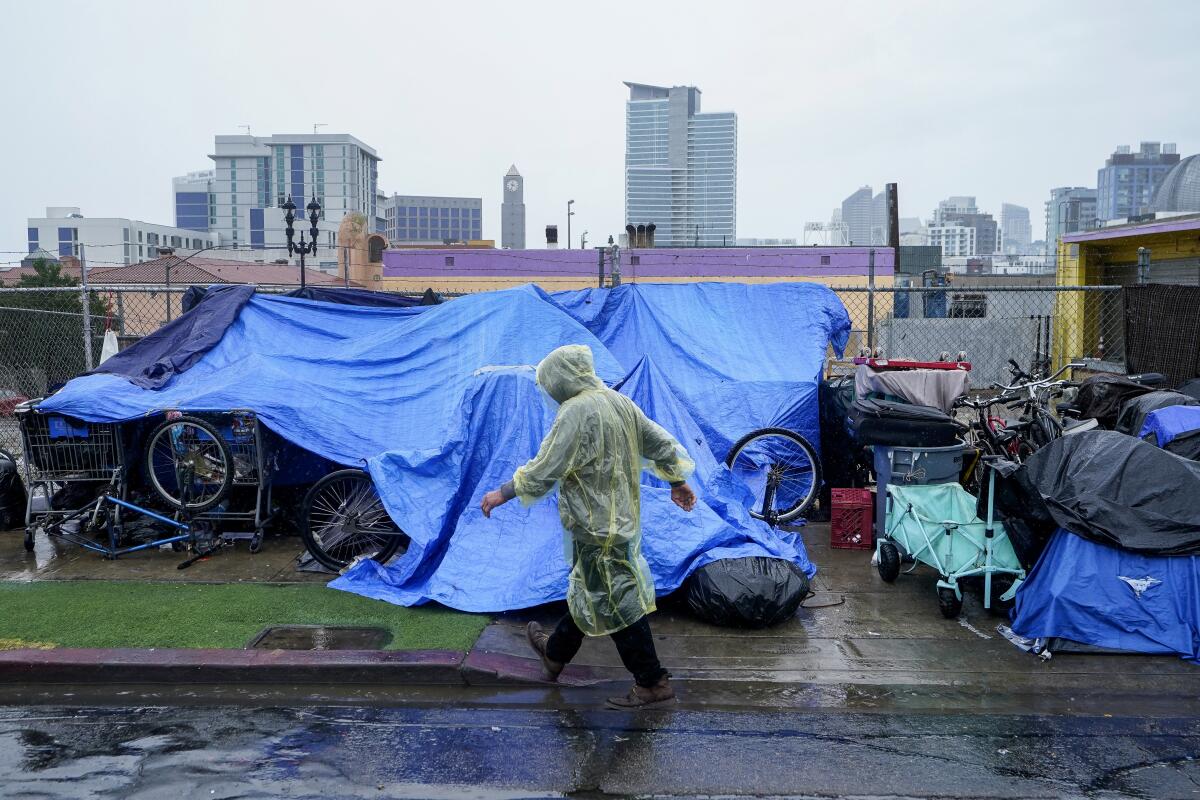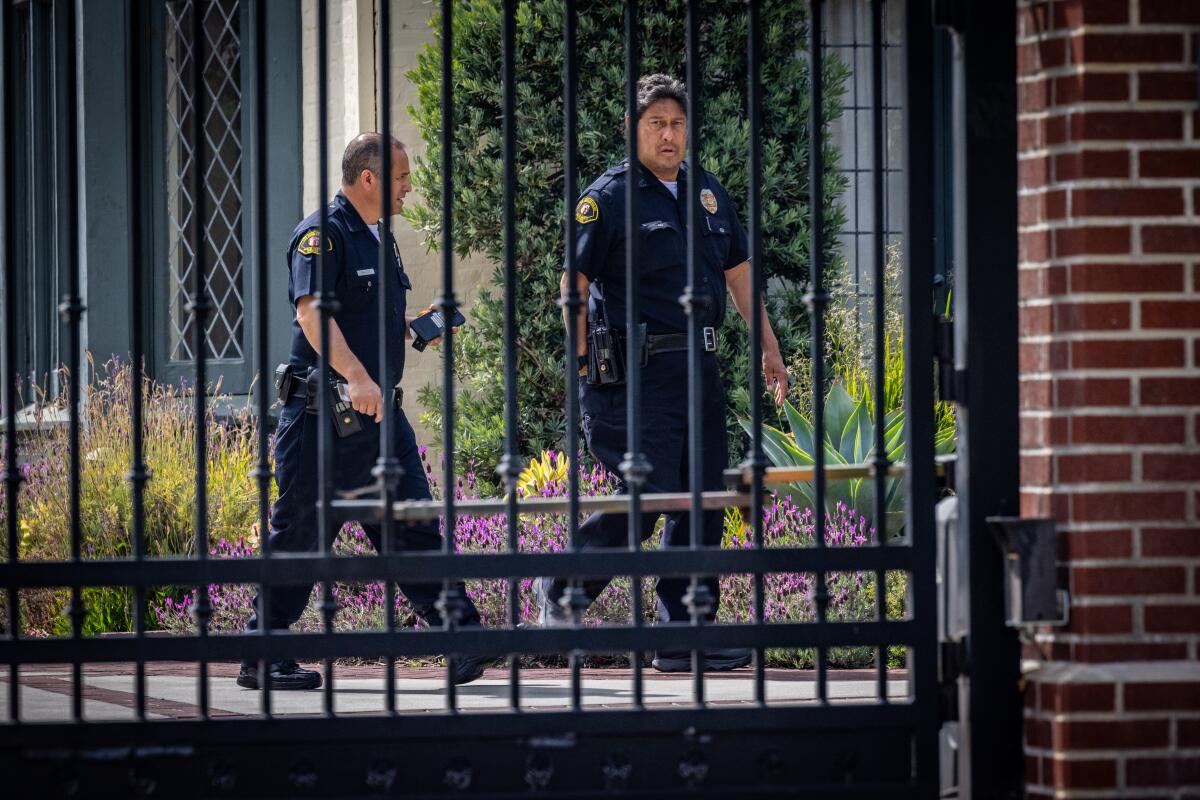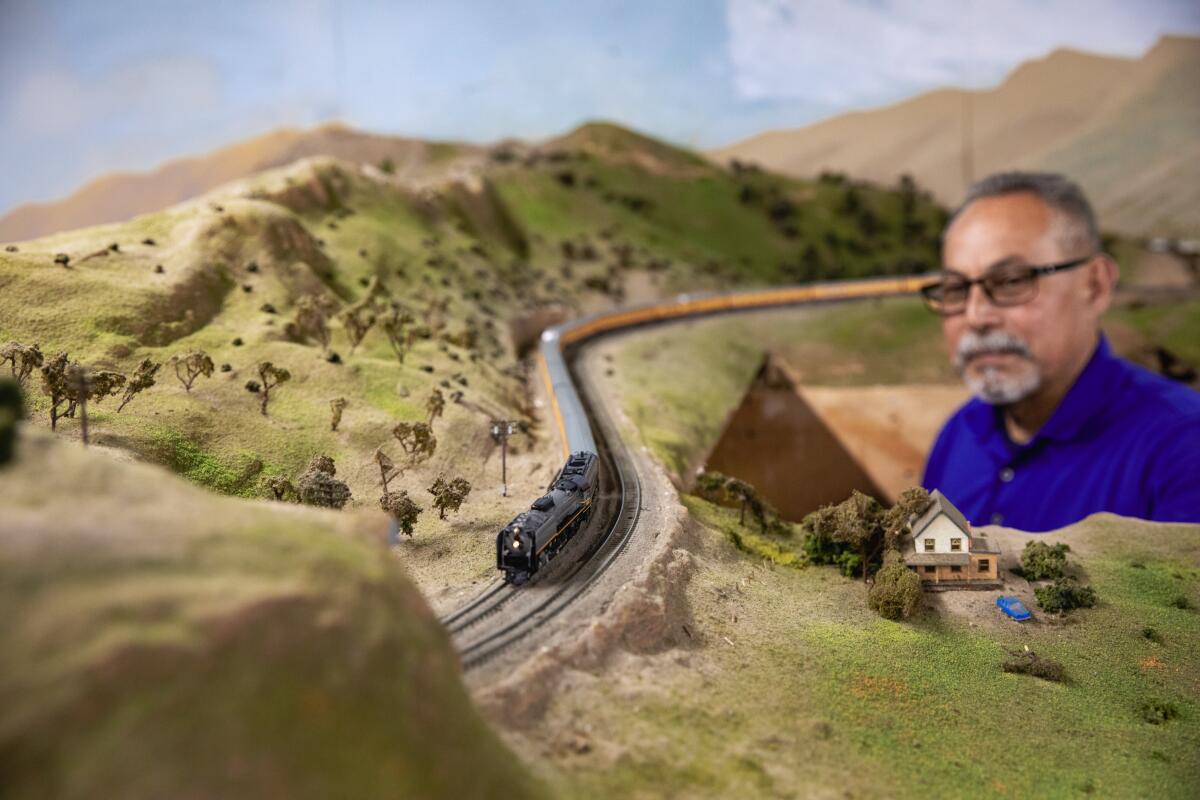Mega shelters and camping bans don’t solve a root cause of homelessness: Housing costs

- Share via
Good morning. It’s Wednesday, April 24. Here’s what you need to know to start your day.
- In San Diego, plans for mega shelters and a recent camping ban don’t get at the root cause of homelessness.
- Gaza protests roil universities from California to New York.
- High-speed rail to Las Vegas is coming as soon as 2028.
- And here’s today’s e-newspaper
You're reading the Essential California newsletter
Our reporters guide you through our biggest news, features and recommendations every morning
You may occasionally receive promotional content from the Los Angeles Times.
‘Managing mode, not solutions mode’
San Diego’s mayor created a department in 2021 to find solutions to the homelessness crisis, signaling a new direction. It hasn’t made things better.
The city’s homelessness count increased 35% from 2022 to 2023. Nearly half of the unsheltered people counted were considered chronically homeless.
Homeless deaths increased about 135% over five years, up to at least 624 last year, according to the San Diego County Medical Examiner’s office.
For every 10 people who find housing in San Diego, 13 people become homeless for the first time, says a 2022 report by the Regional Task Force on Homelessness.
And 19% of households who exited the city’s shelter system last year fell back into “homeless situations,” according to San Diego Housing Commission data.
“Homelessness is the most complex problem for which people crave a simple solution,” San Diego Mayor Todd Gloria told me. “And there isn’t one.”
A camping ban has moved the problem from one part of town to another
Gloria has championed the city’s controversial Unsafe Camping Ordinance, which bans people from sleeping outside close to schools, transit hubs and shelters, or in parks and other open spaces.
But just because residents, business owners and tourists are seeing fewer tents downtown doesn’t mean homelessness is being reduced.
“Tents line San Diego’s highway on- and off-ramps, where the city can’t enforce its ban because Caltrans owns the land,” CalMatters’ Marisa Kendall reported earlier this month.
Disjointed efforts make progress challenging
Michael McConnell has spent nearly 15 years advocating and providing aid for San Diego’s homeless communities.
He characterized the city’s current approach as “managing mode, not solutions mode” — like using a teaspoon to keep a bathtub from overflowing.
“If we were to build a homeless service system from scratch, it would look nothing like what it looks like today,” McConnell said. “It’s so fragmented.”
The nonprofits and providers that the city relies on each need funding and have varying approaches, he said, which creates competition and undermines collective progress. And with no one strategy in place, it’s hard for elected officials to effect change.

If you ask Gloria, it’s not so simple.
“I have very blunt instruments with regard to responding to homelessness,” Gloria told me. “It’s the sanitation department or the police department. Neither of those are the social workers or human services agencies.”
A group of businessmen has floated a different version of moving homeless people around.
George Mullen, who grew up in San Diego, said the severity of the humanitarian crisis requires radical solutions.
He and a group of residents have an idea: build a facility to house thousands of their homeless neighbors, several miles outside of town.
They call it Sunbreak Ranch. It would serve as a large-scale “triage center” complete with shelter, health treatment, job support, schools and daily shuttle service to downtown San Diego.
The Sunbreak group’s website includes among its goals a “return to the rule of law” and cleaning up city streets that are “filthy beyond recognition.”
Proponents say the federal government should declare a national emergency and build the facility on federal land, similar to how FEMA responds to natural disasters.
Mullen and his collaborators have been pitching a version of the idea for years, and found support from a former mayor and former U.S. Housing and Urban Development Secretary Ben Carson. But it’s been dismissed or criticized.
- The San Diego Union-Tribune editorial board said “Mullen’s messianic tone only adds to his utter lack of credibility.”
- Mayor Gloria told me “there’s not a lot of depth to the proposal.”
- McConnell worried that the proposal could encourage those who “think it’s a good idea to just ship folks out somewhere.”
- The Marine Corps called the idea “not supportable” due to wildlife habitat, live-fire gun ranges and unexploded ordinance. (Mullen’s group also proposed an alternate site.)
Mullen is unperturbed.
“Why not try?” he said. “Do you just let people keep dying? Or do you actually try to do something to get them off the streets?”
City officials are pushing their mega-shelter plans
Mayor Gloria announced a plan earlier this month to convert a massive warehouse near San Diego International Airport to a long-term mega-shelter with 1,000 beds. The site would include 24-hour security, meals, showers and other amenities, plus services to connect people with housing.
Another large shelter being considered, dubbed H Barracks, initially aimed to provide temporary beds for up to 700 people, also near the airport. The plan faced some local opposition in the fall when more than 6,000 residents signed a Change.org petition urging the city to kill the idea.
Gloria said that the H Barracks plan could change if city leaders act on his new proposal and sign a long-term lease for the warehouse site.
None of these shelter proposals address housing costs
San Diego was recently ranked the most expensive U.S. city to live in by U.S. News and World Report.
Gloria called the lack of affordable housing the “primary cause” of the current crisis.
“It is not uncommon to have a conversation with a resident who is incensed about our homelessness crisis but will simultaneously, in the very same conversation, share their opposition to more housing,” Gloria said.
It’s one place where advocates and the mayor agree.
“None of these ideas are going to solve homelessness without homes for people to go into,” McConnell said. “People don’t drop out of the sky onto the street; they were in housing, and they became homeless. These were your housed neighbors and now they’re your unhoused neighbors.”
Today’s top stories

Intruder at Mayor Bass’ home
- An intruder made it to the second floor of L.A. Mayor Bass’ home: Here’s what we know.
- A suspect is arrested in a break-in at the home of L.A. Mayor Karen Bass.
- A suspect in a break-in at Mayor Bass’ home was previously convicted of assault.
- The break-in suspect left a bloody scene while ‘targeting’ Mayor Bass, prosecutors say.
High speed rail
- High-speed rail to Las Vegas is coming as soon as 2028. Here are more details.
- SoCal to Vegas in two hours? High-speed rail comes closer to reality with $3-billion award.
- Biden touts high-speed rail between Southern California and Las Vegas.
Gaza protests on college campuses
- ‘We will not move.’ Pro-Palestinian encampments and protests grow at California universities.
- Gaza protests roil universities from California to New York; tensions grow at Humboldt and Berkeley.
More big stories
- Should property owners get a tax rebate because of the homeless crisis? Arizona voters will decide.
- Google fired at least 20 additional workers after last week’s Gaza protest, group says.
- Why Disney is doubling down on theme parks with a $60-billion plan.
- These are the California cities where $150,000 still buys you a home. Would you live here?
- L.A. student dies after safety team member allegedly does not intervene to try to prevent a fight.
- Man accused of killing woman on L.A. subway is linked to earlier violence on Metro train.
- She was saving money to move back to Nicaragua. Then she was killed on a L.A. subway.
- Comic Elayne Boosler can’t talk her way out of handbag at Dodger Stadium. She was handcuffed.
- California increases water allocation after a wet winter, but fish protections limit pumping.
- A lawsuit filed on behalf of nine couples accuses a Newport Beach fertility clinic of poisoning embryos.
- Artificial intelligence-powered cameras are being installed on Los Angeles Metro buses to help ticket cars parked in bus lanes.
- L.A. sees a surge of billboards for personal injury lawyers. You’ll never guess why.
Get unlimited access to the Los Angeles Times. Subscribe here.
Commentary and opinions
- Editorial: In eco-minded California, there’s still no constitutional right to clean air and water.
- Robin Abcarian: Criminalizing homelessness is unconscionable, but is it unconstitutional?
- Editorial: Don’t believe the nonsense. The criminal justice system worked properly in Venice assaults.
- Michael Hiltzik: As taxpayers tire of handouts to billionaires, Major League Baseball demands public funding for a Vegas stadium.
- Gustavo Arellano: Starting with his favorite cheesesteak haunt, Kobe Bryant’s spirit is all over Philadelphia.
Today’s great reads

After Hamas killed his mother, an Israeli man chooses peace over vengeance. After his mother’s death, Carmel Neta tried not to get angry. He did not seek revenge. To honor his mother, he drew closer to his Palestinian neighbors and an experimental bilingual school. During a bleak time, the school was a source of light — and hope. If schoolchildren could get along, couldn’t the adults do so too?
Other great reads
- This 5-year-old from Gaza is learning to live with one leg and untold loss.
- Anne Hathaway recalls ‘gross’ chemistry tests from the early 2000s: ‘Now we know better.’
- Melissa Barrera is not afraid.
How can we make this newsletter more useful? Send comments to [email protected].
For your downtime

Going out
- Xochitl Gomez’s 5 favorite Latino-owned businesses in L.A.
- What to know about California’s new state park, a scenic green space where two rivers meet.
Staying in
- ‘The Synanon Fix’ — now streaming on HBO — shows how the California dream went awry for a rehab group turned cult.
- 🧑🍳 Here’s a recipe for pomelo with yogurt cream and sweet crumbles.
- ✏️ Get our free daily crossword puzzle, sudoku, word search and arcade games.
And finally ... a great photo
Show us your favorite place in California! We’re running low on submissions. Send us photos that scream California and we may feature them in an edition of Essential California.

Today’s great photo is from Times contributor Joel Barhamand at the Belmont Shore Railroad Club in San Pedro.
Have a great day, from the Essential California team
Ryan Fonseca, reporter
Defne Karabatur, fellow
Andrew Campa, Sunday reporter
Kevinisha Walker, multiplatform editor and Saturday reporter
Christian Orozco, assistant editor
Stephanie Chavez, deputy metro editor
Karim Doumar, head of newsletters
Check our top stories, topics and the latest articles on latimes.com.
Sign up for Essential California
The most important California stories and recommendations in your inbox every morning.
You may occasionally receive promotional content from the Los Angeles Times.




